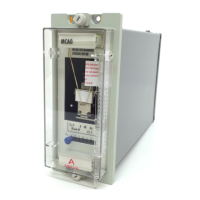10
R
ST
=
V
S
- R
r
I
r
=
44
- 0.02
1
= 43.98 Ω
V
f
=
I
f
(R
CT
+ 2R
L
+ R
r
+ R
ST
)
= 27820x
5
x
(0.3+0.08+0.02+44)
1500
= 27820 x 0.148
= 4117.36V
= I
f
(R
CT
+ 2R
L
)
= 7.98 (0.3 + 0.02)
= 2.55V
V
p
= 2 2 V
K
(V
f
- V
K
)
= 2 2 x 70.4 x (4117.36 - 70.4)
= 1509.7V
V
p
= 2 2 V
K
(V
r
- V
K
)
.
I
e
@ 44V <
1.4 - 1
..
4
< 0.1A
Stabilising resistor
Assuming that the relay effective
setting for a solidly earthed power
transformer is approximately 30% of
full load current, we can therefore,
choose a relay current setting of
20% of 5A i.e. 1A. On this basis
the required value of stabilising
resistor is:
5A rated MCTI14 relays are
supplied with stabilising resistors
that are continuously adjustable
between 0 and 47Ω. Thus, a
stabilising resistance of 44Ω can be
set using the standard resistor.
Current transformer
requirements
The minimum current transformer
kneepoint voltage
V
K
= 1.6V
S
= 1.6 x 44
= 70.4V
The exciting current to be drawn by
the current transformers at the relay
stability voltage, V
S
, will be:
Metrosil non-linear resistor
requirements
If the peak voltage appearing
across the relay circuit under
maximum internal fault conditions
exceeds 3000V peak then a
suitable non-linear resistor (metrosil),
externally mounted,
should be connected across the
relay and stabilising resistor, in
order to protect the insulation of the
current transformers, relay and
interconnecting pilots. In the present
case the peak voltage can be
estimated by the formula:
where V
K
= 70.4V (In practice this
should be the actual current
transformer kneepoint voltage,
obtained from the current
transformer magnetisation curve).
Therefore substituting these values
for V
K
and V
f
in the above formula it
can be seen that the peak voltage
developed by the current
transformer is:
This value is well below the
maximum of 3000V peak and
therefore no metrosils are required
with the relay. If, on the other hand,
the peak voltage V
P
given by the
formula had been greater than
3000V peak, a non-linear resistor
(metrosil) would have to be
connected across the relay and the
stabilising resistor. The
recommended non-linear resistor
type would have to be chosen in
accordance with the maximum
secondary current at the relay.
Generator winding
differential protection using
MCAG34
For the vast majority of MCAG14/
34 and MCTI14/34 applications
(restricted earth fault protection and
busbar protection), the
aforementioned formulae may be
followed without any additional
consideration. For MCAG34/
MCTI34 generator winding
differential applications, which are
less common applications, some
caution may be necessary in using
these formulae alone.
The relatively low level of current
that is delivered by a generator to
an external fault means that stability
of high impedance generator
differential protection can easily be
achieved with a relatively low
protection stability voltage. In many
applications, there is no need to
utilise stabilising resistors in series
with the high impedance relay
(indicated by negative stabilising
resistor value); the impedance of the
relay elements alone will offer more
than adequate stability. Where the
protection is over stable, literal
application of the published CT
kneepoint voltage formula by a CT
designer would result in the
provision of CT`s with extremely low
kneepoint voltage, which could
result in lack of protection scheme
sensitivity and slow relay operation
for an internal fault.
The correct application of the
MCAG34 when applied as
generator winding differential
protection is illustrated in Figure 10
which shows a typical application of
the MCAG34 relay where the use of
the procedure detailed in example 2
would lead to an extremely low
kneepoint voltage requirement. This
can be avoided by calculation of
the kneepoint voltage using the
actual value for V
SA
(setting voltage)
rather than the value of V
s
required
for stability in the event of an
external fault.
Stability voltage
The required relay stability voltage
(assuming one CT saturated)
Using the standard formula, this
would lead to a CT VK requirement
of 2 x 2.55 = 5.1V
I
e
< I
S
- I
r
n
where
I
S
= relay effective setting
= 30
x 1391 x
5
100 1500
=1.4A
I
r
= relay setting
= 1A
n = number of current
transformers in parallel
with the relay
= 4

